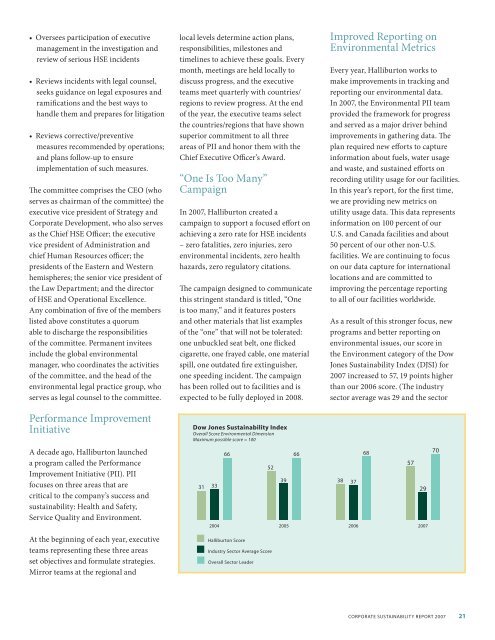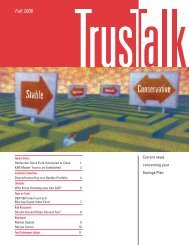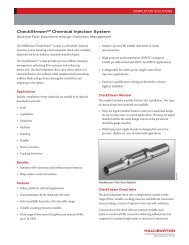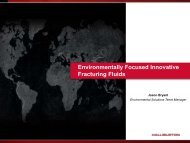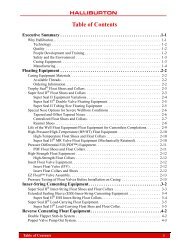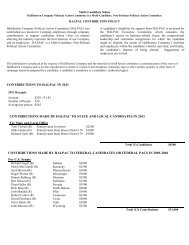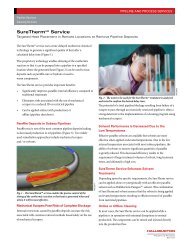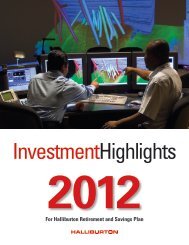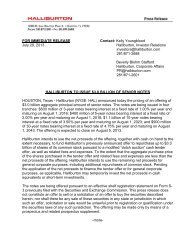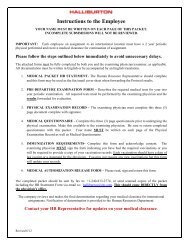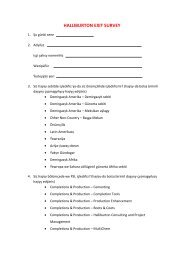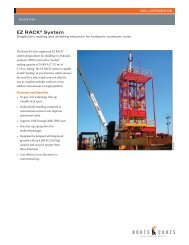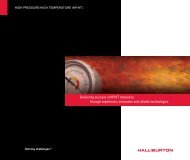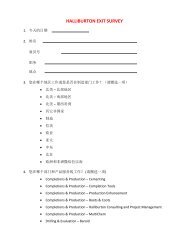2007 Corporate Sustainability Report - Halliburton
2007 Corporate Sustainability Report - Halliburton
2007 Corporate Sustainability Report - Halliburton
You also want an ePaper? Increase the reach of your titles
YUMPU automatically turns print PDFs into web optimized ePapers that Google loves.
• Oversees participation of executive<br />
management in the investigation and<br />
review of serious HSE incidents<br />
• Reviews incidents with legal counsel,<br />
seeks guidance on legal exposures and<br />
ramifications and the best ways to<br />
handle them and prepares for litigation<br />
• Reviews corrective/preventive<br />
measures recommended by operations;<br />
and plans follow-up to ensure<br />
implementation of such measures.<br />
The committee comprises the CEO (who<br />
serves as chairman of the committee) the<br />
executive vice president of Strategy and<br />
<strong>Corporate</strong> Development, who also serves<br />
as the Chief HSE Officer; the executive<br />
vice president of Administration and<br />
chief Human Resources officer; the<br />
presidents of the Eastern and Western<br />
hemispheres; the senior vice president of<br />
the Law Department; and the director<br />
of HSE and Operational Excellence.<br />
Any combination of five of the members<br />
listed above constitutes a quorum<br />
able to discharge the responsibilities<br />
of the committee. Permanent invitees<br />
include the global environmental<br />
manager, who coordinates the activities<br />
of the committee, and the head of the<br />
environmental legal practice group, who<br />
serves as legal counsel to the committee.<br />
local levels determine action plans,<br />
responsibilities, milestones and<br />
timelines to achieve these goals. Every<br />
month, meetings are held locally to<br />
discuss progress, and the executive<br />
teams meet quarterly with countries/<br />
regions to review progress. At the end<br />
of the year, the executive teams select<br />
the countries/regions that have shown<br />
superior commitment to all three<br />
areas of PII and honor them with the<br />
Chief Executive Officer’s Award.<br />
“One Is Too Many”<br />
Campaign<br />
In <strong>2007</strong>, <strong>Halliburton</strong> created a<br />
campaign to support a focused effort on<br />
achieving a zero rate for HSE incidents<br />
– zero fatalities, zero injuries, zero<br />
environmental incidents, zero health<br />
hazards, zero regulatory citations.<br />
The campaign designed to communicate<br />
this stringent standard is titled, “One<br />
is too many,” and it features posters<br />
and other materials that list examples<br />
of the “one” that will not be tolerated:<br />
one unbuckled seat belt, one flicked<br />
cigarette, one frayed cable, one material<br />
spill, one outdated fire extinguisher,<br />
one speeding incident. The campaign<br />
has been rolled out to facilities and is<br />
expected to be fully deployed in 2008.<br />
Improved <strong>Report</strong>ing on<br />
Environmental Metrics<br />
Every year, <strong>Halliburton</strong> works to<br />
make improvements in tracking and<br />
reporting our environmental data.<br />
In <strong>2007</strong>, the Environmental PII team<br />
provided the framework for progress<br />
and served as a major driver behind<br />
improvements in gathering data. The<br />
plan required new efforts to capture<br />
information about fuels, water usage<br />
and waste, and sustained efforts on<br />
recording utility usage for our facilities.<br />
In this year’s report, for the first time,<br />
we are providing new metrics on<br />
utility usage data. This data represents<br />
information on 100 percent of our<br />
U.S. and Canada facilities and about<br />
50 percent of our other non-U.S.<br />
facilities. We are continuing to focus<br />
on our data capture for international<br />
locations and are committed to<br />
improving the percentage reporting<br />
to all of our facilities worldwide.<br />
As a result of this stronger focus, new<br />
programs and better reporting on<br />
environmental issues, our score in<br />
the Environment category of the Dow<br />
Jones <strong>Sustainability</strong> Index (DJSI) for<br />
<strong>2007</strong> increased to 57, 19 points higher<br />
than our 2006 score. (The industry<br />
sector average was 29 and the sector<br />
Performance Improvement<br />
Initiative<br />
Dow Jones <strong>Sustainability</strong> Index<br />
Overall Score Environmental Dimension<br />
Maximum possible score = 100<br />
A decade ago, <strong>Halliburton</strong> launched<br />
a program called the Performance<br />
Improvement Initiative (PII). PII<br />
focuses on three areas that are<br />
critical to the company’s success and<br />
sustainability: Health and Safety,<br />
Service Quality and Environment.<br />
31 33<br />
2004<br />
66 66 68<br />
52<br />
39 38 37<br />
2005<br />
2006<br />
57<br />
29<br />
<strong>2007</strong><br />
70<br />
At the beginning of each year, executive<br />
teams representing these three areas<br />
set objectives and formulate strategies.<br />
Mirror teams at the regional and<br />
<strong>Halliburton</strong> Score<br />
Industry Sector Average Score<br />
Overall Sector Leader<br />
<strong>Corporate</strong> <strong>Sustainability</strong> <strong>Report</strong> <strong>2007</strong> 21


